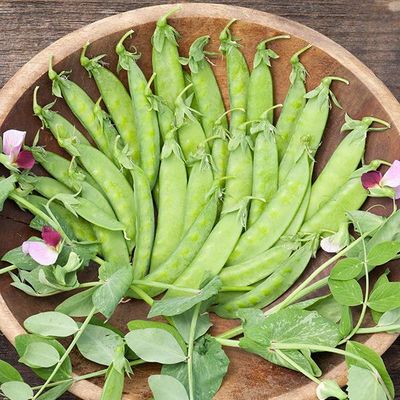Johnson's Home & Garden
We're Not Your Typical Store! Locally Owned and Operated Established 1995Welcome to Johnson's Home & Garden
Product Description

Red blossoms for pea shoots and garnish.
An old snow pea variety now cast in additional roles for its crops of red blossoms and subtly reddish-tinted stems and leaves. Shoots are used as garnishes and in salad mixes. Preferred for both taste and tenderness. Small snow pea pods avg. 2½" long. 28" vines may be grown with or without support.
• Edible Flowers: The flowers, with their mild and pea-like flavor, are a popular choice for brightening up salad mix. They can also be used in micro mix salads, as a garnish for desserts, or for candying to place on cakes.
Prized for both its edible pods and purple flowers, the "Dwarf Grey" sugar pea variety grows up to 3 feet tall and thrives in cool, wet climates. The initial planting can be made in early spring, and a second crop can be started in late summer so that the pods can be enjoyed again in the fall. The sugar pea pods can be eaten straight from the plant, stir-fried or steamed, and the plant grows easily with plenty of sunlight and water.
Prepare a sunny spot in the garden in early spring that is somewhat protected from the wind by loosening the soil with a rake or hoe. Heavy soil, such as clay, may need to be tilled or spaded.
Add organic matter, such as compost or peat, to enrich the soil prior to planting the "Dwarf Grey" peas. This is especially necessary with heavier soils.
Use a gloved finger to dig a small trench, approximately 1 1/2 inches deep, in a straight line. Place one seed every 2 inches in the trench, and then cover the seeds gently with dirt.
Space rows of dwarf grey sugar peas every 2 feet to provide plenty of growing space. If you are limited on gardening space, they can be sown slightly closer.
Water the soil without soaking it, and keep it moist. Seeds take seven to 14 days to germinate. The soil needs to remain moist through germination, through blooming and until the seed pods begin to swell with peas. At this point, scale back on watering so that the plants receive around 1/2 inch of water a week.
Tip Seeds can be planted every three weeks to have a continual harvest. Planting rows in a north to south direction provides better sun exposure and air circulation. For a fall crop of peas, plant new seeds in late July.
Avg. 3,400 seeds/lb.
An old snow pea variety now cast in additional roles for its crops of red blossoms and subtly reddish-tinted stems and leaves. Shoots are used as garnishes and in salad mixes. Preferred for both taste and tenderness. Small snow pea pods avg. 2½" long. 28" vines may be grown with or without support.
• Edible Flowers: The flowers, with their mild and pea-like flavor, are a popular choice for brightening up salad mix. They can also be used in micro mix salads, as a garnish for desserts, or for candying to place on cakes.
Prized for both its edible pods and purple flowers, the "Dwarf Grey" sugar pea variety grows up to 3 feet tall and thrives in cool, wet climates. The initial planting can be made in early spring, and a second crop can be started in late summer so that the pods can be enjoyed again in the fall. The sugar pea pods can be eaten straight from the plant, stir-fried or steamed, and the plant grows easily with plenty of sunlight and water.
Prepare a sunny spot in the garden in early spring that is somewhat protected from the wind by loosening the soil with a rake or hoe. Heavy soil, such as clay, may need to be tilled or spaded.
Add organic matter, such as compost or peat, to enrich the soil prior to planting the "Dwarf Grey" peas. This is especially necessary with heavier soils.
Use a gloved finger to dig a small trench, approximately 1 1/2 inches deep, in a straight line. Place one seed every 2 inches in the trench, and then cover the seeds gently with dirt.
Space rows of dwarf grey sugar peas every 2 feet to provide plenty of growing space. If you are limited on gardening space, they can be sown slightly closer.
Water the soil without soaking it, and keep it moist. Seeds take seven to 14 days to germinate. The soil needs to remain moist through germination, through blooming and until the seed pods begin to swell with peas. At this point, scale back on watering so that the plants receive around 1/2 inch of water a week.
Tip Seeds can be planted every three weeks to have a continual harvest. Planting rows in a north to south direction provides better sun exposure and air circulation. For a fall crop of peas, plant new seeds in late July.
Avg. 3,400 seeds/lb.



